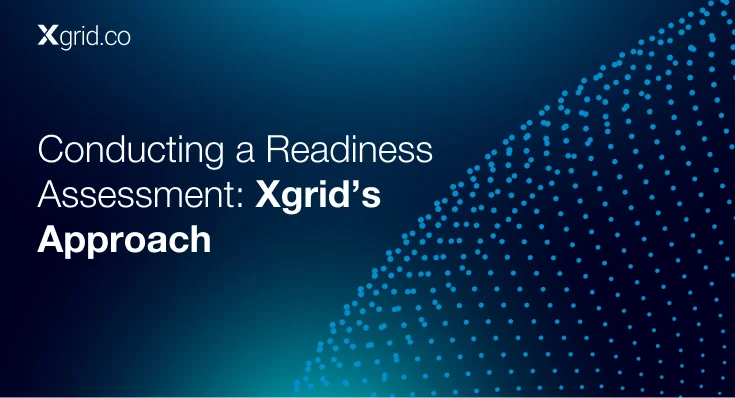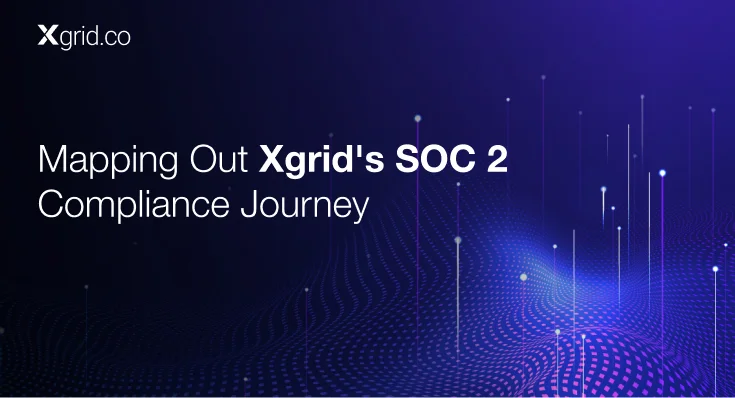How Xgrid Defined Its SOC 2 Audit Scope
As we embark on our SOC 2 journey, one of the most critical steps was defining the audit scope, a process that required careful consideration of the systems, services, and controls that impact security, availability, processing integrity, confidentiality, and privacy.
In this blog post, we’ll share how Xgrid defined its SOC 2 audit scope and the strategic decisions we made to ensure a comprehensive yet focused audit.
1. Understanding the Importance of SOC 2 Scope Definition
Before diving into the specifics of the scope definition, it’s essential to understand why this step matters. SOC 2 reports are designed to demonstrate that an organization has appropriate controls in place to protect customer data.
However, not every part of an organization needs to be audited. The scope definition ensures that the audit focuses on the systems and processes that directly affect the trust service criteria (TSCs) relevant to your business and customers. This keeps the audit manageable and focused on key risks.
Key Considerations for SOC 2 Scope:
-
-
- Customer Expectations: What security controls and policies do customers expect?
- Applicable Systems and Services: Which of our systems and services impact our ability to meet SOC 2’s trust principles?
- Audit Efficiency: How can we ensure the scope is comprehensive but also efficient to audit?
-
2. Aligning the Scope with Business Objectives
At Xgrid, our SOC 2 scope was defined in close alignment with our business objectives and the services we offer. As a provider of cloud-based solutions, we identified that the bulk of our customer interaction and service delivery was through our SaaS platforms and cloud infrastructure.
This focus allowed us to narrow down the audit scope to the systems that directly handle customer data and drive core service functions.
Key areas identified for SOC 2 scope:
-
-
- Cloud Infrastructure (AWS and Azure environments)
- SaaS platforms that Xgrid offers to customers
- Customer data storage and processing mechanisms
- Access controls and security systems
- Incident management and response processes
-
By focusing on these areas, we ensured that the audit addressed the parts of the business most critical to customer security without overextending into areas not directly relevant to SOC 2 compliance.
3. Mapping Xgrid’s Systems to SOC 2 Trust Service Criteria
SOC 2 audits are centered around the trust service criteria (TSCs): security, availability, processing integrity, confidentiality, and privacy.
For Xgrid, security and confidentiality were the primary criteria due to the nature of our services, but availability and processing integrity were also crucial, given that our clients rely on uninterrupted access to our platforms.
How Xgrid mapped systems to TSCs:
-
-
- Security: We audited systems such as firewalls, VPNs, and IDS/IPS solutions to ensure data is protected from unauthorized access. Our cloud security configurations, user access controls, and encryption practices were also in scope.
- Confidentiality: We reviewed data storage systems and policies around encryption, data masking, and access control, ensuring customer data is stored and transmitted securely.
- Availability: To ensure uptime and reliability, we included our disaster recovery systems, load balancers, and redundancy architectures.
- Processing Integrity: Systems that handle transaction processing, automated workflows, and data validation were included to confirm that data is processed accurately and consistently.
-
By linking each system and service to a TSC, we could ensure the audit was comprehensive while remaining focused on customer and regulatory expectations.
4. Identifying Key Business Processes and Controls
Once we identified the systems in scope, the next step was to map out the business processes and controls that support them.
Controls are the policies and procedures that govern how we manage, secure, and monitor our systems. For Xgrid, we focused on controls related to user access, change management, system monitoring, and incident response.
Example controls in scope:
-
-
- Access Management: Controls over provisioning, modifying, and revoking access for employees, contractors, and third parties.
- Change Management: Processes for documenting, reviewing, and approving system changes to ensure they don’t introduce security risks.
- Monitoring and Logging: Controls for monitoring system activity and reviewing logs to detect and respond to potential incidents.
- Incident Response: Our incident response plan and procedures for managing and reporting data breaches or security incidents.
-
Each of these processes was reviewed to ensure they met SOC 2 requirements and were appropriately documented.
5. Addressing Third-Party Dependencies
Xgrid, like many modern organizations, relies on third-party service providers for various parts of its infrastructure, such as cloud hosting and data storage.
These third-party services play a critical role in delivering our solutions, and as a result, we needed to include them in the scope of our SOC 2 audit.
To manage third-party risks, we conducted a thorough assessment of each vendor’s SOC reports, security practices, and SLAs to ensure that they align with our trust service criteria.
Steps we took to manage third-party dependencies:
-
-
- Vendor SOC Reports: We collected and reviewed SOC reports from all critical service providers (e.g., AWS, Azure) to ensure their controls meet SOC 2 requirements.
- SLAs and Contracts: We reviewed service level agreements (SLAs) to ensure vendors were contractually obligated to maintain the security and availability of their systems.
- Monitoring and Auditing: Ongoing monitoring of third-party security practices through audits, penetration testing, and vulnerability assessments.
-
6. Incorporating Feedback from Stakeholders
Defining the scope of a SOC 2 audit is not a one-size-fits-all process. It requires input from various stakeholders across the organization.
At Xgrid, we involved teams from IT, security, legal, compliance, and customer success to ensure that the scope reflected both operational realities and customer expectations.
How we managed stakeholder engagement:
-
-
- Workshops and Discussions: We conducted workshops with key stakeholders to gather input on what systems, processes, and controls should be in scope.
- Risk Assessment: A company-wide risk assessment helped us identify the areas most vulnerable to security incidents or failures in availability.
- Customer Feedback: Our customer success team collected feedback from key clients about their security concerns and expectations regarding our SOC 2 compliance.
-
This cross-functional approach ensured that our scope was relevant, comprehensive, and aligned with both internal and external requirements.
7. Continuous Scope Refinement
As Xgrid grows and evolves, so too will our SOC 2 scope. New services, system changes, and evolving security risks will require continuous refinement of our scope to ensure that we maintain our commitment to customer security and regulatory compliance.
Key actions for continuous improvement:
-
-
- Regular Risk Assessments: We conduct annual risk assessments to identify new risks or systems that need to be added to the SOC 2 scope.
- Customer Input: Ongoing customer feedback informs scope adjustments and control improvements.
- Control Audits: Internal audits help ensure that all controls in scope are functioning effectively and are updated as needed.
-
Conclusion
Defining the SOC 2 audit scope was a collaborative, strategic process that allowed Xgrid to focus on the most critical areas of our business while ensuring compliance with the SOC 2 framework.
By aligning our scope with business objectives, mapping systems to trust service criteria, addressing third-party risks, and incorporating stakeholder input, we created a well-rounded and efficient audit scope that positions Xgrid for continued growth and success in the security and compliance landscape.
Stay tuned for the next blog in our SOC 2 journey, where we will dive into how Xgrid implemented security controls across our infrastructure to meet the rigorous demands of SOC 2 compliance!

Established in 2012, Xgrid has a history of delivering a wide range of intelligent and secure cloud infrastructure, user interface and user experience solutions. Our strength lies in our team and its ability to deliver end-to-end solutions using cutting edge technologies.
OFFICE ADDRESS
US Address:
Plug and Play Tech Center, 440 N Wolfe Rd, Sunnyvale, CA 94085
Dubai Address:
Dubai Silicon Oasis, DDP, Building A1, Dubai, United Arab Emirates
Pakistan Address:
Xgrid Solutions (Private) Limited, Bldg 96, GCC-11, Civic Center, Gulberg Greens, Islamabad
Xgrid Solutions (Pvt) Ltd, Daftarkhwan (One), Building #254/1, Sector G, Phase 5, DHA, Lahore




